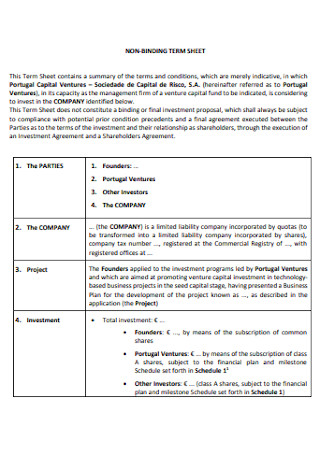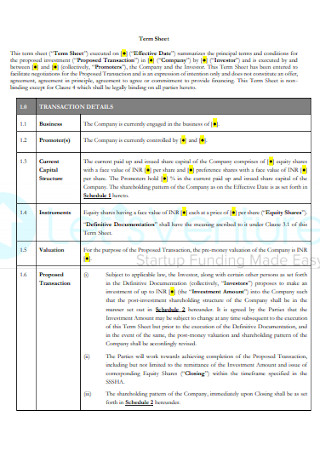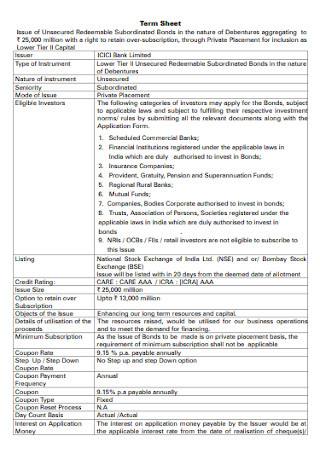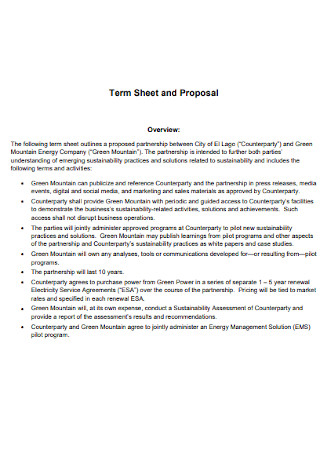45+ Sample Term Sheets
-

Non Binding Term Sheet
download now -

Term Sheet for Investors
download now -

Term Sheet and Model Form
download now -

Sample Term Sheet
download now -

Financing Term Sheet
download now -

Company Term Sheet
download now -

Venture Capital Term Sheet
download now -

Term Sheet for Equity Investments
download now -

Anatomy of an Investor Term Sheet
download now -

Summary of General Term Sheet
download now -

Pandemic Term Sheet
download now -

Anatomy of Term Sheet
download now -

Indicative Term Sheet
download now -

Simple Term Sheet Template
download now -

Contract Term Sheet
download now -

Corporation Term Sheet
download now -

Basic Term Sheet Template
download now -

Pricing Term Sheet
download now -

Demand Protection Term Sheet
download now -

Guarantee Term Sheet
download now -

Final Term Sheet
download now -

Early Stage Term Sheet
download now -

Standard Term Sheet Template
download now -

Convertible Note Term Sheet
download now -

Term Deposits Term Sheet
download now -

Contract Summary Term Sheet
download now -

Senior Debt Term Sheet
download now -

Preliminary Term Sheet
download now -

Commercial Term Sheet
download now -

Pricing Term Sheet Example
download now -

Lease Term Sheet
download now -

Confidential Term Sheet
download now -

Bluebird Terrm Sheet
download now -

Contract Approval Term sheet
download now -

Term Sheet and Proposal
download now -

Term Sheet for Agreement
download now -

Term Sheet for Potential Investment
download now -

Term Sheet for Settlement Agreement
download now -

Preliminary Restructuring Term Sheet
download now -

Techstars Form for Term Sheet
download now -

Term Sheet for Company Investment
download now -

Formal Term Sheet
download now -

Simple Term Sheet Template
download now -

Venture Capital Term Sheet Template
download now -

Final Term Term Sheet
download now -

Term Sheet for Finance
download now
What Is a Term Sheet?
A term sheet is a nonbinding arrangement highlighting an investment’s fundamental terms and conditions. Term sheets are most commonly associated with new companies. Businesses believe the document is vital for attracting investors with assets, including venture capitalists. The term sheet includes information such as the company valuation, investment amount, percentage stake, voting rights, liquidation preference, anti-dilutive provisions, and investor commitment. Term sheets are also available for mergers and acquisitions for long-term debt. Term sheets are not legally binding; however, they frequently include a good faith deposit or other indication that both parties intend to carry out an executed total agreement. A term sheet in a merger or tried acquisition generally includes details about the initial purchase price offer, preferred payment method, and assets in the transaction. The document also incorporates information about deal exclusions or any items that one or both parties consider specifications. Business owners and other investors enter the “due diligence” phase after the transaction’s completion with all negotiated terms by both parties. Both parties consent to a time frame for this step, during which potential investors solidify details about the company’s early stages, such as organization and financial projects.
According to the United Nations Conference on Trade and Development (UNCTAD) and their World Investment Report for 2022, global foreign direct investments (GFDI) in 2021 amount to 1.48 billion US dollars, showing an increase of 64 percent from the previous year. Many investors invest in various industries and sectors, hoping to reduce inflation and grow the economy.
Components of a Term Sheet
When a startup business owner decides to obtain additional funds through a possible investor and investment deal, they must create a term sheet. Business owners usually generate the document when they have already set up their brand and reputation and are looking for additional investment opportunities to expand their business operations or have them operate and function at a similar level or pace as they have during their prime. There are various ways for individuals to compose their term sheets. There are essential components that must be present in the document, following the list below.
How To Develop a Coherent and Comprehensive Term Sheet
When preparing a term sheet, the investor and business owner perform collaborative work, wherein either investors or business owners develop the term sheet. Understanding all the necessary terms, conditions, and provisions in a term sheet is one of the critical things to consider when signing off, with all the necessary information to make it less of a daunting task to create. Knowing how to complete and develop a term sheet gives individuals an edge in understanding the process. Consider the steps below to prepare a term sheet and develop a coherent and comprehensive document.
1. Give a Brief Summary of the Terms and Conditions
Develop a brief paragraph detailing the principal terms and conditions that are present in the term sheet document. The individual lists information about a target company that the term sheet addresses, whether the term sheet is a binding or non-binding agreement, and the names of the buyers. If a term sheet is a non-binding document, it must state that the investors do not commit to investing in a company, and it all depends on the closing deal incorporated in the document. Depending on the requirements of a term sheet, it includes various details about various matters concerning the term sheet.
2. List All the Offering Terms
After the summary, indicate the offering terms of the document, consisting of the closing date and conditions, the document’s issuer, offering amount, price per share, involved investors, securities, and pre-money valuations. This step in creating the term sheet focuses on offers and deals. The section sets up another part of the term sheet outlining the primary aspects of negotiations. The closing date refers to the date when both parties agree on the terms and conditions of the document. When listing the names of investors, it is optional to indicate the type of share, share percentage, and the money offered by investors in the offering terms. As such, the offering amount and price per share from investors usually go together. Securities and pre-money valuations must include a list of the purchased shares by investors, class A, class B, preferred shares, preferred common stocks, and warrants. Valuations are percentages for ownership, with the pre-money valuation added to the investment amount.
3. Insert the Dividends, Provisions, and Liquidation Preferences
Dividends refer to the profit distribution to company shareholders, with the value of the dividends accruing over time that the organization distributes as a stock or in cash. There are various types of dividends, including non-cumulative, cumulative, and anti-dilution. Non-cumulative dividends are determined by the board of directors each fiscal year. Cumulative dividends favor investors involved in the investment deal and are not advisable for startups. Meanwhile, anti-dilution investments protect the rights of preferred stockholders if the company decreases in value. Liquidation preference refers to the preferred protection of preferred stocks if something goes wrong. Liquidation preference equates to the invested amount, guaranteeing that investors still acquire a lump sum of their investments. When it comes to provisions, these specify the rights of parties if there are things that do not fall into place. Protective plans are in place, addressing different problems and issues, and returning what is rightful to investors if the company’s value decreases.
4. Indicate Participation Rights
Participation rights protect investors in cases they require their return on investment for the company. These rights give investors protection similar to the liquidation preferences, giving them an opportunity for the return on their investment before others in the deal can acquire their shares. Investors also receive a specific percentage from what’s left of returns if there are no claimants. Through the provision, many investors fully participate in startups without risking a major loss of their investments. With all the benefits to investors, this part of the term sheet takes time to have an agreement. Participation tights are an optional section in the term sheet, and the entire document still serves its function and purpose if both parties agree not to incorporate the provision. Participation rights are not standard as founders cannot benefit from it, and if the involved parties decide on its incorporation, there must be a maximum return amount.
5. Set Up a Board of Directors
The board of directors is an essential part of a startup company. For a newly formed company beginning to grow and develop, most of the power shifts from the company founder to the people responsible for managing the organization. The board of directors is a crucial part of an institution, and term sheets incorporate necessary provisions about company structures and voting rights. As such, the board is a vital control mechanism for companies. Since they are essential components of an organization, the term sheet indicates the board of directors. Even if a company has a sole founder, forming a board of directors helps envision company growth and development. If an organization does not have an official list of board members, it can include founders and investors.
6. Write a Voting Agreement and Other Matters
For the final stage of developing the term sheet, including the board and founder matters, optional pools, and share purchasing agreement. The board and founder matters detail voting rights and agreements and board member selection, among other things. When adding voting rights and procedures, it must indicate the matters requiring director or investor approval. The optional pool refers to the amount of stock a company reserves for its current and future employees, making it a necessary addition to the term sheet. After the approval of the addition of stocks, the issuance process is also a vital topic to address. If the organization already has an optional pool available, it can revise, improve, or add it to the term sheet. Despite it being an essential part of a term sheet, there is no requirement for an optional pool.
FAQs
How many pages does a term sheet have?
A term sheet is a short document that investors or business owners prepare that details the terms and conditions of investments, roughly five to eight pages in length.
What are the five fundamental points in a term sheet?
The five fundamental points that any term sheet must contain are valuation or estimate, board of director rights, investor protection provisions, share agreements, and additional securities and provisions.
Does a term sheet equate to an agreement?
Unless the term sheet explicitly specifies that it is a binding agreement, most term sheets are not legally binding.
Term sheets are valuable documents for business owners, especially those individuals needing a specific amount of investment to grow and develop their organization further. Business owners and investors must work collaboratively to create a term sheet that benefits both parties, not just the investors and not just the owners. In creating the term sheet, present a clear valuation and estimate for the investments to diminish confusion and misunderstandings. Familiarize yourself with the components and steps in developing the term sheet before engaging in investment deals. Browse through the collection of term sheet sample templates, finding a suitable document to manage investment meetings with potential investors.
